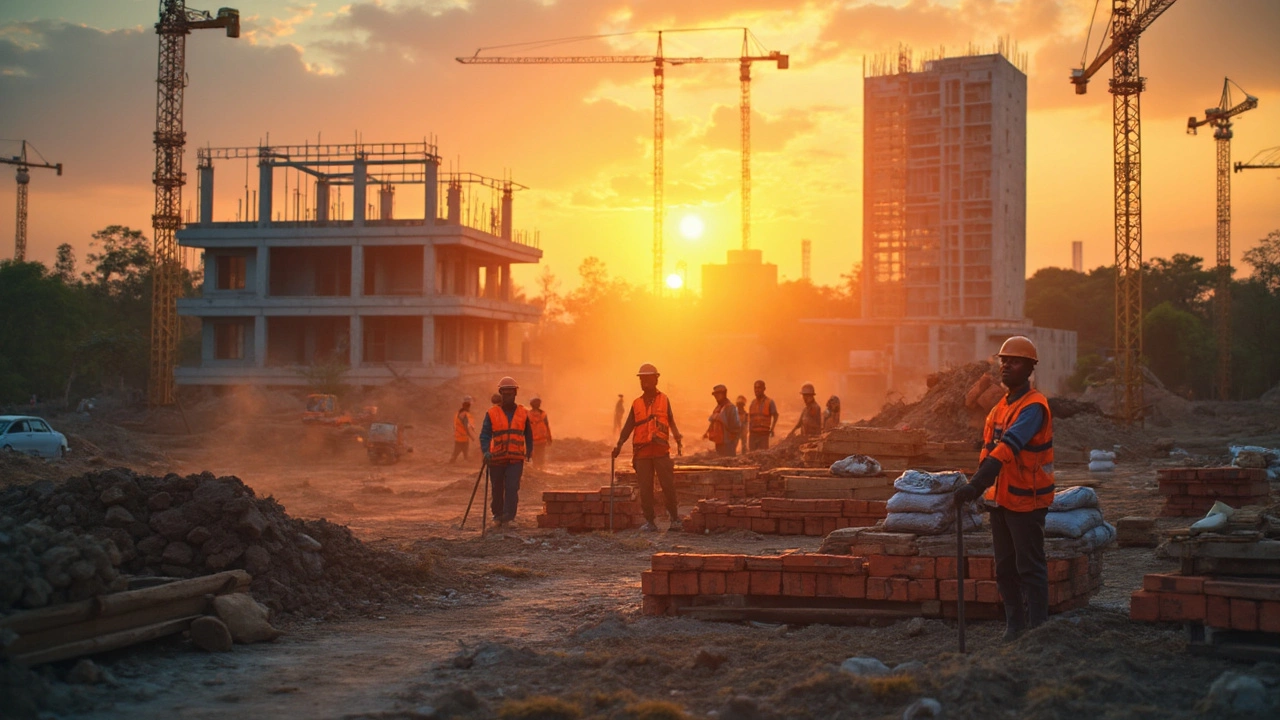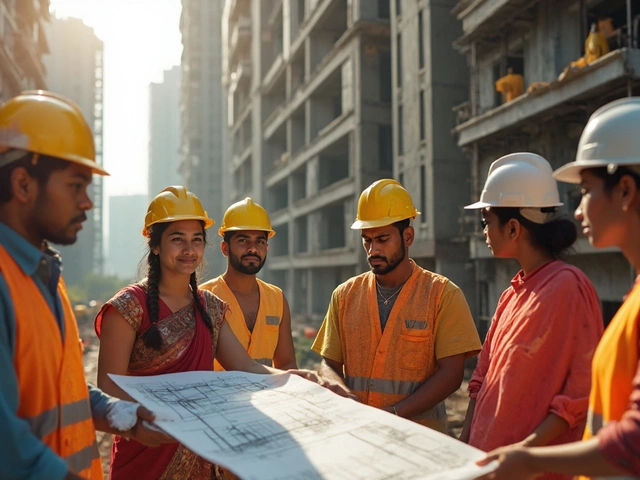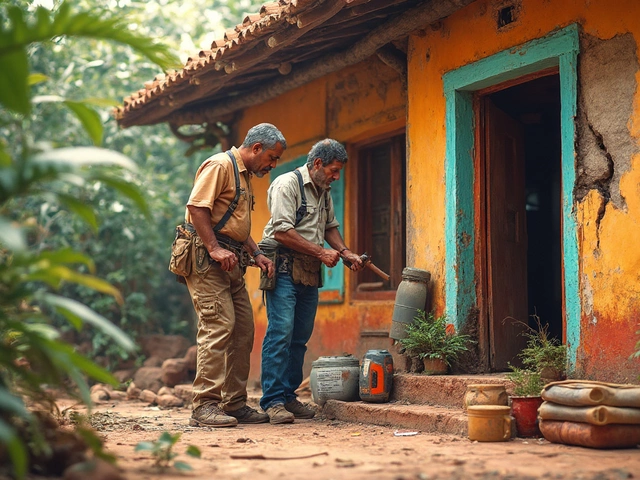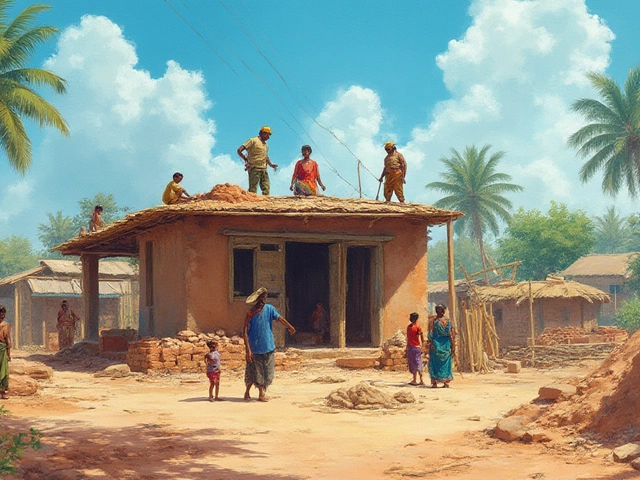If you’ve ever stared at a building site and wondered what all that stuff is, you’re not alone. Construction isn’t just about pouring concrete and sticking bricks together. Every structure you see starts with a handful of basic materials that almost everything else depends on. These raw materials get turned into all sorts of things—like beams, bricks, cement, and steel frames—that hold up our homes and offices.
Why does this matter for you? Well, knowing what goes into your walls can actually save you money, help you make smarter decisions, and maybe even avoid a construction disaster. Ever heard of a guy running out of sand for his concrete mix and having to pay triple because he ignored the basics? That’s the kind of rookie mistake you can dodge with the right know-how.
Let’s break down the real essentials. We’re talking about the five primary raw materials the construction world can’t live without: stone, sand, clay, wood, and iron ore. Each one has its own job, quirks, and must-know tips. Whether you’re a DIY weekend warrior or someone who’s just curious about what’s under the paint on your wall, it pays to know the foundations.
- What Counts as a Primary Raw Material?
- Stone: Nature’s Original Powerhouse
- Sand: The Hidden Giant Behind Concrete
- Clay: From Dirt to Bricks and Tiles
- Wood: Nature’s Versatile Wonder
- Iron Ore: The Backbone of Steel Structures
What Counts as a Primary Raw Material?
When construction folks talk about “primary raw materials,” they mean the basic stuff you dig up, cut down, or scoop out of the earth before it’s turned into anything else. These are the materials that get used as starting points for pretty much every building project out there. Think of them like the flour, eggs, and milk in your favorite pancake recipe—you can’t make much without them.
So, what makes a material “primary” in the construction world? Here’s what matters:
- It comes straight from natural sources without major processing.
- It’s used to make other building materials, like cement, glass, steel, or bricks.
- It forms the backbone of everything built—skyscrapers, sidewalks, highways, you name it.
The most common primary raw materials are stone, sand, clay, wood, and iron ore. Each plays a different role, but without them, there’d be no buildings, no roads, and no bridges connecting your city.
Here’s a quick look at how much of these materials get used every year, just to give you a feel for the scale:
| Material | Global Annual Use (Billion Tons) |
|---|---|
| Stone | 28 |
| Sand | 50 |
| Clay | 4 |
| Wood | 3.5 |
| Iron Ore | 2.6 |
That’s not just trivia—it explains why these materials are always in demand and why the cost can swing up or down fast. Next time you hear about a shortage, now you’ll know why it matters.
Stone: Nature’s Original Powerhouse
When people think about building, stone comes to mind first. It’s been used since the pyramids, and honestly, there’s a reason you still see it everywhere. Stone is stupidly tough. Once it’s set in place, you’re not moving it without some serious machinery.
Builders reach for stone mainly because it lasts for centuries, can handle crazy weather, and is pretty fire-resistant. That’s why you spot it in old castles, bridges, steps, and a ton of city landmarks. Granite, limestone, marble, and sandstone are the most popular types. Each one serves a different purpose—granite for countertops and heavy-duty stuff, limestone for walls and landscaping, marble for a fancier look, and sandstone because it’s easy to shape.
Check out this quick snapshot of stone facts:
| Type of Stone | Main Use | Notable Feature |
|---|---|---|
| Granite | Structural beams, countertops | Highly durable |
| Limestone | Walls, cement production | Easy to cut |
| Marble | Flooring, tiles, décor | Polished finish |
| Sandstone | Paving, walls | Flexible to shape |
There’s another big thing about stone—maintenance. It doesn’t need much. Give it a wash every year or two, and it’s happy. There’s also less risk of mold or pests, compared to wood. But keep in mind, stone is heavy and can be pricey to haul. So if you live somewhere far from a quarry, your wallet’s going to feel it.
Want a quick tip? If you care about sustainability, locally-sourced stone is better for the environment and often cheaper. Plus, it fits right in with your area’s climate, which can make your construction more solid in the long run. There’s a reason stone still leads the pack for the primary raw materials in construction. When you want something that’s going to outlast you, you can’t beat it.
Sand: The Hidden Giant Behind Concrete
Every time you pass a building, highway, or even a backyard patio, there’s a good chance sand helped make it possible. Sand is everywhere in construction, but it gets way less attention than steel or wood. That’s wild, considering how much we use—global construction eats up around 50 billion tons of sand every year. That makes it one of the most-consumed resources on the planet, only beat by water.
Sand’s big role is in making concrete. Concrete is basically just sand, gravel, cement, and water mixed together. You might be surprised to hear that sand makes up about 30% of a typical concrete mix. Builders care a lot about the size and quality of the grains because the wrong sand can make concrete crumbly or even dangerous. River sand is the gold standard, but it’s getting harder to find, leading folks to use alternatives like crushed rock.
Here’s a quick look at why sand’s so important in concrete and other construction stuff:
- Strength and Stability: The right sand makes concrete solid. Bad sand? Cue cracks and crumbling over time.
- Smooth Finish: Fine sand gives smoother surfaces on walls, floors, and walkways.
- Brick Making: Mixes of sand and clay create the bricks that line up in most walls.
- Plasterwork: Sand helps make plaster stick and spread well without lumps or bumps.
One weird problem that’s coming up? Sand shortages. Believe it or not, not all sand works for building—beach sand is often too round and smooth, so it won’t lock together in concrete. Illegal sand mining is a real thing and has caused problems in parts of India, Southeast Asia, and even closer to home if you live in a fast-growing city.
| Type of Sand | Common Use | Notes |
|---|---|---|
| River Sand | Concrete, mortar | Preferred for strength, but supplies are shrinking fast |
| Crushed Stone Sand | Concrete, masonry | Made by crushing rocks, now used more to replace river sand |
| Manufactured Sand (M-Sand) | Concrete, plaster | Engineered to have the right size and shape; more consistent than natural sands |
| Desert Sand | Rarely used | Grains are too smooth for good bonding in concrete |
So if you’re planning a project, keep sand in mind. Always ask your supplier where the sand comes from and if it suits your job. Buying the wrong type might seem cheaper upfront, but it can cost way more later if your concrete crumbles or your brick walls start to bulge. And hey, if you think it’s silly to worry about sand running out, just ask someone who’s paid double after a local shortage. It’s not a hassle you want to deal with.

Clay: From Dirt to Bricks and Tiles
Most people look at clay and just see mud, but in the construction world, clay is the real MVP for everything from sturdy walls to rooftops. When you combine clay with water and a little heat, you can get some of the strongest, most durable building materials out there. Think of classic red bricks, those heavy roof tiles, and even certain pipes—they all come from humble clay.
Here’s a quick breakdown of why clay is a go-to for builders:
- Primary raw material for making bricks, tiles, and ceramic pipes.
- When fired in a kiln at temps over 900°C (that’s over 1,650°F), clay transforms into a rock-solid material.
- Clay bricks are naturally fire-resistant and great for insulation, helping keep buildings cool in the summer and warm in the winter.
- Because of their density, clay bricks can even block out a decent amount of noise—handy if you live near a busy street.
Wondering how popular clay bricks actually are? Take a look at these numbers:
| Material | Annual Global Production (million tons) |
|---|---|
| Clay Bricks | 1,350 |
| Clay Roof Tiles | 230 |
That’s a lot of bricks and tiles—enough to circle the earth more times than you’d think!
If you’re choosing clay for your build, pay attention to the type. Not all clay is the same. For bricks, you want “fire clay” or “surface clay”—they stick together well and handle heat like a champ. Lower-grade clay can crumble when it dries or gets wet, which is the last thing you want in a wall.
- Tip: Bricks made from good clay have a sharp, clear sound when you knock two together. If they just thud, skip ‘em.
- Tip: Clay tiles are heavier than concrete ones. Make sure your roof structure can handle the weight before switching your material.
Clay isn’t just sturdy; it’s low-maintenance too. Unlike wood, clay won’t rot or become a termite buffet. And if you care about the environment, clay is pretty eco-friendly—when sourced responsibly, it doesn’t deplete natural resources or pollute water.
Wood: Nature’s Versatile Wonder
Wood is the Swiss Army knife of construction materials. It’s pretty much everywhere—from the frame of your house, to flooring, fences, and roof trusses. What makes it a favorite? It’s strong but flexible, easy to work with, and, if you pick the right species, it lasts for decades—even centuries with a little care.
Not all wood is the same, though. Builders usually pick between softwood and hardwood. Softwoods like pine and spruce are cheaper and easy to cut, so you’ll find them in framing and plywood. Hardwoods like oak or maple cost more but handle dents, scratches, and the weather better, so they’re perfect for things like flooring, furniture, and fancy trim.
Here’s what gives wood the edge in construction:
- Strength for its weight: Wood can hold loads without being super heavy, which is handy for floors and walls.
- Shock resistance: Wood bends before it snaps, so buildings are less likely to break when things shift or shake.
- Works with simple tools: You don’t need a ton of fancy gear—just saws, drills, and some nails or screws.
- Insulation: Wood naturally holds heat in and keeps cold out—good news for your energy bills.
- Renewable: It literally grows on trees. Managed forests keep the supply going without trashing the environment.
Let’s look at just how much wood is used. In the United States alone, over 70% of homes are primarily built using wood framing. Cross-laminated timber (CLT), a high-tech wood product, is now going toe-to-toe with steel and concrete in some multi-story buildings, especially in cities trying to cut their carbon footprint.
| Wood Type | Common Use | Average Cost ($/board foot) |
|---|---|---|
| Pine | Framing, plywood, trim | 2 |
| Oak | Flooring, cabinetry, doors | 6 |
| Spruce | Roof trusses, studs, general carpentry | 2.5 |
| Maple | Flooring, cabinetry | 7 |
| Fir | Beams, construction lumber | 3 |
If you’re buying wood, here’s a tip: check for knots and warping, and always go for kiln-dried lumber if possible. It’s less likely to twist and split. Store your wood flat and off the ground if you’re not using it right away—nothing hurts more than seeing your boards turn into a banana shape overnight.
Last thing: wood isn’t fireproof, but it does give signs of trouble—like smoke and charring—before failing. That’s why builders still trust it, especially for homes, even in our high-tech age. Just keep an eye on moisture and pests, and wood will treat you well for years.
Iron Ore: The Backbone of Steel Structures
Iron ore is where steel gets its power. Pretty much every skyscraper, bridge, or giant warehouse you see today would've never stood up without it. Iron ore rocks are packed with iron, and once you melt them down and mix in a little carbon, you’ve got steel—strong stuff that’s in almost every major construction materials project.
Here’s something wild: about 98% of all mined iron ore ends up as steel. That’s millions of tons every year fueling everything from beams and rebar to nuts, bolts, and support columns. Without iron ore, our modern cities would look totally different—think way fewer high-rises and metal roofs, and a lot more wood and stone.
You might not see it, but the process to turn raw ore into finished steel is intense. First, giant machines dig up the ore, which looks kind of like rusty rocks. Then, it gets crushed and tossed into a furnace at temperatures hotter than most volcanoes. Add coke (a pure form of carbon) and a blast of hot air, and soon you’ve got molten iron ready to become steel.
Steel is popular for two big reasons: it’s super strong for its weight, and it stands up to weather, earthquakes, and even fire way better than most other materials. That’s why engineers love it for foundations and tall buildings that need to handle heavy loads or rough conditions.
- Why use steel? It’s versatile, easy to shape, and lasts for decades if treated right.
- Want rust-proof steel? Look for galvanized or stainless types—they handle moisture better, which is key for outdoor or coastal projects.
- Recycling steel saves major energy—over 60% of new steel products are made with recycled metal these days.
Check out how much iron ore feeds the construction world:
| Year | Global Iron Ore Production (Million Tons) | Percent Used for Steel |
|---|---|---|
| 2015 | 3,120 | 97% |
| 2020 | 3,380 | 98% |
| 2024 | 3,510 | 98% |
If you’re planning any project that needs to handle weight or last a long time, steel made from iron ore is pretty much non-negotiable. You just don’t get the same reliability with substitutes.






